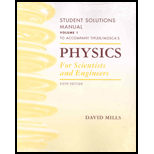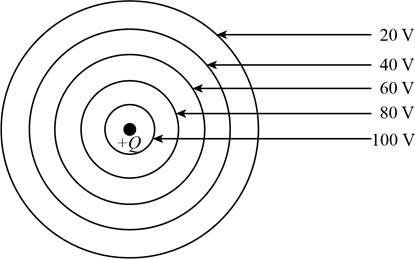
Concept explainers
(a)
The shape of the equipotential surfaces in the region around the charge.
(a)
Explanation of Solution
Introduction:
The supplementary and inherent essential property of some subatomic particles such as electron due to which they interact with each other is known as electric charge. The standard unit of electric charge is Coulomb which is symbolized as
The appearance of the equipotential surfaces in the region around the charge is concentric with the middle wire as the geometry of the Geiger tube is cylindrical. An equipotential surface is a surface that is either real or imaginary around a point charge. The electric potential on the equipotential surface is equivalent at each point, and these equipotential surfaces are formed at some distance from the point charge.
Conclusion:
Therefore, the shape of the equipotential surfaces in the region around the charge is concentric with the central or middle wire.
(b)
The radii of the five surfaces that have potentials equals to
(b)
Answer to Problem 64P
The radii of the five surfaces that have potentials equals to
Explanation of Solution
Given:
The potential of first surface is
The potential of second surface is
The potential of third surface is
The potential of fourth surface is
The potential of fifth surface is
Formula used:
The expression for the relationship between electric potential due to point charge and the electric field of the point charge is given by,
Calculation:
Suppose the potential to be zero at
The radius for
The radius for
The radius for
The radius for
The radius for
The sketch is shown below.

Figure 1
Conclusion:
Therefore, the radii of the five surfaces that have potentials equals to
(c)
The spacing between the equipotential surfaces.
(c)
Explanation of Solution
Introduction:
The surface where the magnitude of gravitational potential is the same at all points is known as equipotential, and it coincides with the directions of the gravitational force. A liquid surface is in equilibrium is the best example to understand the concept of the equipotential surface.
The spacing between the equipotential surfaces is closest together but are not equally spaced, it means the electric field becomes stronger. If the field is not performing any work on the particle as it travels from one position to another then the direction of the field’s force must be normal to the direction of the movement of the particle.
Conclusion:
Therefore, the spacing between the equipotential surfaces is closest together
(d)
The electric field strength between
(d)
Answer to Problem 64P
The electric field strength between
Explanation of Solution
Given:
The potential of equipotential surface has
Formula used:
The expression for the average value of the magnitude of the electric field is given as,
The expression for the exact value of the electric field strength is given as,
Calculation:
The average value of the magnitude of the electric field is calculated as,
The exact value of the electric field strength is calculated as,
Conclusion:
Therefore, the electric field strength between
Want to see more full solutions like this?
Chapter 23 Solutions
Physics For Scientists And Engineers Student Solutions Manual, Vol. 1
- A large metal plate is charged uniformly to a density of a=2.0109C/m2 . How far apart are the equipotential surfaces that represent a potential difference of 25 V?arrow_forwardThe dielectric to be used in a parallel-plate capacitor has a dielectric constant of 3.60 and a dielectric strength of 1.60107 V/m. The capacitor has to have a capacitance of 1.25 nF and must be able to withstand a maximum potential difference 5.5 kV. What is the minimum area the plates of the capacitor may have?arrow_forwardA point charge of q=50108 C is placed at the center of an uncharged spherical conducting shell of inner radius 6.0 cm and outer radius 9.0 cm. Find the electric potential at (a) r = 4,0cm, (b) r = 8.0 cm, (c) r — 12.0 cm.arrow_forward
- How many electrons should be removed from an initially uncharged spherical conductor of radius 0.300 m to produce a potential of 7.50 kV at the surface?arrow_forwardWhen a potential difference of 150. V is applied to the plates of an air-filled parallel-plate capacitor, the plates carry a surface charge density of 3.00 1010 C/cm2. What is the spacing between the plates?arrow_forwardThe three charged particles in Figure P20.11 are at the vertices of an isosceles triangle (where d = 2.00 cm). Taking q = 7.00 C, calculate the electric potential at point A, the midpoint of the base. Figure P20.11arrow_forward
- An air-filled parallel-plate capacitor with capacitance C0 stores charge Q on plates separated by distance d. The potential difference across the plates is V0 and the energy stored is PEC,0. If the capacitor is disconnected from its voltage source and the space between the plates is then filled with a dielectric of constant = 2.00, evaluate the ratios (a) Cnew/C0, (b) Vnew/V0, and (c) PEC,new/PEC,0.arrow_forward(i) Rank the following five capacitors from greatest to smallest capacitance, noting any cases of equality, (a) a 20-F capacitor with a 4-V potential difference between its plates (b) a 30-F capacitor with charges of magnitude 90 C on each plate (c) a capacitor with charges of magnitude 80 C on its plates, differing by 2 V in potential. (d) a 10-F capacitor storing energy 125 J (e) a capacitor storing energy 250 J with a 10-V potential difference (ii) Rank the same capacitors in part (i) from largest to smallest according to the potential difference between the plates, (iii) Rank the capacitors in part (i) in the order of the magnitudes of the charges on their plates, (iv) Rank the capacitors in part (i) in the order of the energy they store.arrow_forwardTwo parallel plates 10 cm on a side are given equal and opposite charges of magnitude 5.0109 C. The plates are 1.5 mm apart. What is the potential difference between the plates?arrow_forward
- A small spherical pith ball of radius 0.50 cm is painted with a silver paint and then -10 C of charge is placed on it. The charged pith ball is put at the center of a gold spherical shell of inner radius 2.0 cm and outer radius 2.2 cm. (a) Find the electric potential of the gold shell with respect to zero potential at infinity, (b) How much charge should you put on the gold shell if you want to make its potential 100 V?arrow_forwardWhen a Leyden jar is charged by a hand generator (Fig. 27.1, page 828), the work done by the person turning the crank is stored as electric potential energy in the jar. When a capacitor is charged by a battery, where does the electric potential energy come from?arrow_forwardA parallel-plate capacitor with capacitance C0 stores charge of magnitude Q0 on plates of area A0 separated by distance d0. The potential difference across the plates is V0. If the capacitor is attached to a battery and the charge is doubled to 2Q0, what are the ratios (a) Cnew/C0 and (b) Vnew/V0? A second capacitor is identical to the first capacitor except the plate area is doubled to 2A0. If given a charge of Q0, what are the ratios (c) Cnew/C0 and (d) Vnew/V0? A third capacitor is identical to the first capacitor, except the distance between the plates is doubled to 2d0. If the third capacitor is then given a charge of Q0, what are the ratios (e) Cnew/C0 and (f) Vnew/V0?arrow_forward

 College PhysicsPhysicsISBN:9781285737027Author:Raymond A. Serway, Chris VuillePublisher:Cengage Learning
College PhysicsPhysicsISBN:9781285737027Author:Raymond A. Serway, Chris VuillePublisher:Cengage Learning Physics for Scientists and Engineers, Technology ...PhysicsISBN:9781305116399Author:Raymond A. Serway, John W. JewettPublisher:Cengage Learning
Physics for Scientists and Engineers, Technology ...PhysicsISBN:9781305116399Author:Raymond A. Serway, John W. JewettPublisher:Cengage Learning Principles of Physics: A Calculus-Based TextPhysicsISBN:9781133104261Author:Raymond A. Serway, John W. JewettPublisher:Cengage Learning
Principles of Physics: A Calculus-Based TextPhysicsISBN:9781133104261Author:Raymond A. Serway, John W. JewettPublisher:Cengage Learning Physics for Scientists and Engineers: Foundations...PhysicsISBN:9781133939146Author:Katz, Debora M.Publisher:Cengage Learning
Physics for Scientists and Engineers: Foundations...PhysicsISBN:9781133939146Author:Katz, Debora M.Publisher:Cengage Learning College PhysicsPhysicsISBN:9781305952300Author:Raymond A. Serway, Chris VuillePublisher:Cengage Learning
College PhysicsPhysicsISBN:9781305952300Author:Raymond A. Serway, Chris VuillePublisher:Cengage Learning





